18F-VC701-PET and MRI in the in vivo neuroinflammation assessment of a mouse model of multiple sclerosis
- PMID: 29402285
- PMCID: PMC5800080
- DOI: 10.1186/s12974-017-1044-x
18F-VC701-PET and MRI in the in vivo neuroinflammation assessment of a mouse model of multiple sclerosis
Abstract
Background: Positron emission tomography (PET) using translocator protein (TSPO) ligands has been used to detect neuroinflammatory processes in neurological disorders, including multiple sclerosis (MS). The aim of this study was to evaluate neuroinflammation in a mouse MS model (EAE) using TSPO-PET with 18F-VC701, in combination with magnetic resonance imaging (MRI).
Methods: MOG35-55/CFA and pertussis toxin protocol was used to induce EAE in C57BL/6 mice. Disease progression was monitored daily, whereas MRI evaluation was performed at 1, 2, and 4 weeks post-induction. Microglia activation was assessed in vivo by 18F-VC701 PET at the time of maximum disease score and validated by radioligand ex vivo distribution and immunohistochemistry at 2 and 4 weeks post-immunization.
Results: In vivo and ex vivo analyses show that 18F-VC701 significantly accumulates within the central nervous system (CNS), particularly in the cortex, striatum, hippocampus, cerebellum, and cervical spinal cord of EAE compared to control mice, at 2 weeks post-immunization. MRI confirmed the presence of focal brain lesions at 2 weeks post-immunization in both T1-weighted and T2 images. Of note, MRI abnormalities attenuated in later post-immunization phase. Neuropathological analysis confirmed the presence of microglial activation in EAE mice, consistent with the in vivo increase of 18F-VC701 uptake.
Conclusion: Increase of 18F-VC701 uptake in EAE mice is strongly associated with the presence of microglia activation in the acute phase of the disease. The combined use of TSPO-PET and MRI provided complementary evidence on the ongoing disease process, thus representing an attractive new tool to investigate neuronal damage and neuroinflammation at preclinical levels.
Keywords: EAE monophasic model; MRI; Multiple sclerosis; Neuroinflammation; TSPO-PET.
Conflict of interest statement
Ethics approval
Animals were maintained and handled in compliance with the institutional guidelines for the care and use of experimental animals (IACUC), which have been notified to the Italian Ministry of Health and approved by the Ethics Committee of the San Raffaele Scientific Institute for studies involving animals.
Consent for publication
Not applicable.
Competing interests
The authors declare that they have no competing of interests.
Publisher’s Note
Springer Nature remains neutral with regard to jurisdictional claims in published maps and institutional affiliations.
Figures
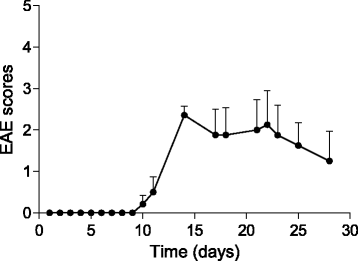
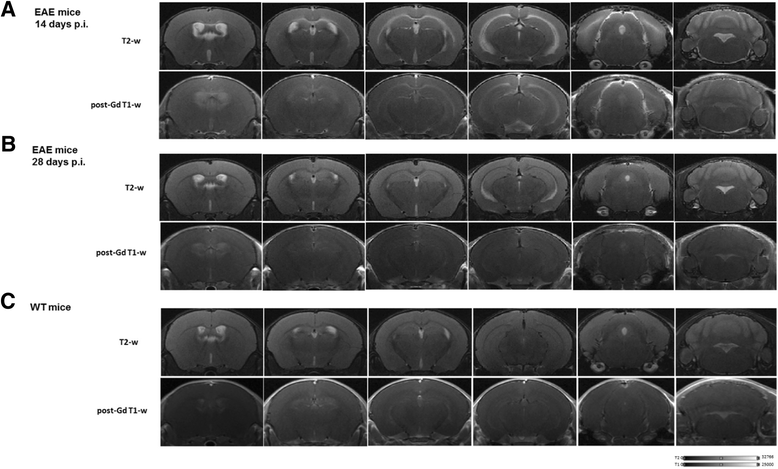
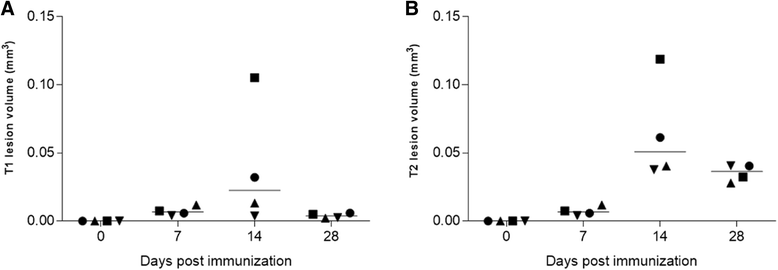
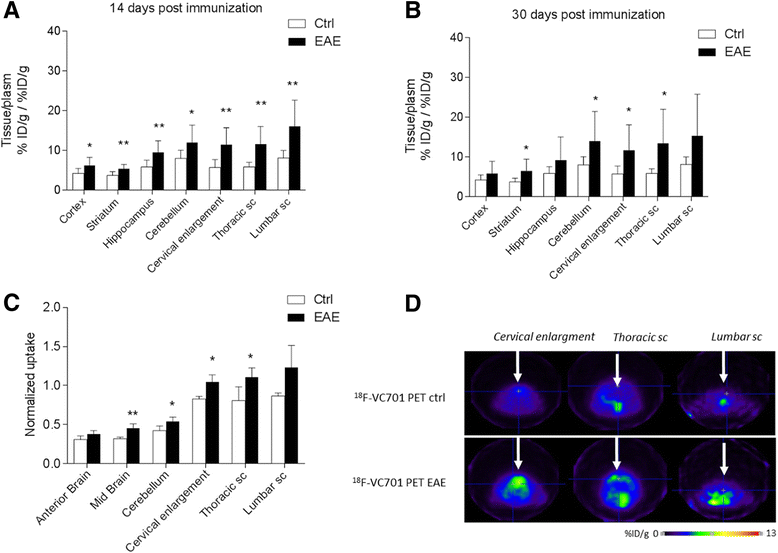
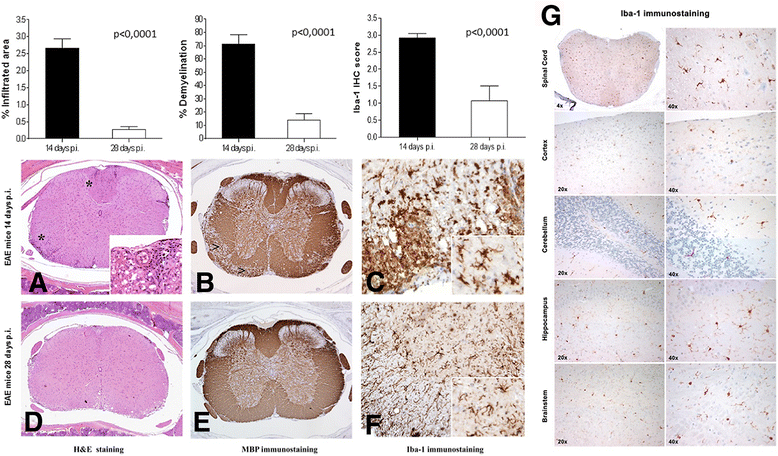
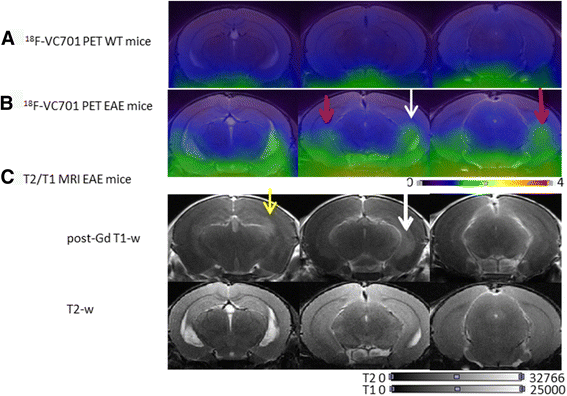
Similar articles
-
[18F]FSPG-PET reveals increased cystine/glutamate antiporter (xc-) activity in a mouse model of multiple sclerosis.J Neuroinflammation. 2018 Feb 22;15(1):55. doi: 10.1186/s12974-018-1080-1. J Neuroinflammation. 2018. PMID: 29471880 Free PMC article.
-
In vivo imaging of CNS microglial activation/macrophage infiltration with combined [18F]DPA-714-PET and SPIO-MRI in a mouse model of relapsing remitting experimental autoimmune encephalomyelitis.Eur J Nucl Med Mol Imaging. 2021 Jan;48(1):40-52. doi: 10.1007/s00259-020-04842-7. Epub 2020 May 7. Eur J Nucl Med Mol Imaging. 2021. PMID: 32378022 Free PMC article.
-
Central nervous system expression and PET imaging of the translocator protein in relapsing-remitting experimental autoimmune encephalomyelitis.J Nucl Med. 2013 Feb;54(2):291-8. doi: 10.2967/jnumed.112.108894. Epub 2013 Jan 15. J Nucl Med. 2013. PMID: 23321458
-
Novel MRI and PET markers of neuroinflammation in multiple sclerosis.Curr Opin Neurol. 2016 Jun;29(3):229-36. doi: 10.1097/WCO.0000000000000326. Curr Opin Neurol. 2016. PMID: 27058220 Review.
-
Positron emission tomography imaging in evaluation of MS pathology in vivo.Mult Scler. 2018 Oct;24(11):1399-1412. doi: 10.1177/1352458518791680. Epub 2018 Aug 9. Mult Scler. 2018. PMID: 30091657 Review.
Cited by
-
CEST MRI and MALDI imaging reveal metabolic alterations in the cervical lymph nodes of EAE mice.J Neuroinflammation. 2022 Jun 3;19(1):130. doi: 10.1186/s12974-022-02493-z. J Neuroinflammation. 2022. PMID: 35659311 Free PMC article.
-
TSPO imaging in animal models of brain diseases.Eur J Nucl Med Mol Imaging. 2021 Dec;49(1):77-109. doi: 10.1007/s00259-021-05379-z. Epub 2021 Jul 10. Eur J Nucl Med Mol Imaging. 2021. PMID: 34245328 Free PMC article. Review.
-
Visual evoked potentials waveform analysis to measure intracortical damage in a preclinical model of multiple sclerosis.Front Cell Neurosci. 2023 May 31;17:1186110. doi: 10.3389/fncel.2023.1186110. eCollection 2023. Front Cell Neurosci. 2023. PMID: 37323584 Free PMC article.
-
Brain sex-dependent alterations after prolonged high fat diet exposure in mice.Commun Biol. 2022 Nov 21;5(1):1276. doi: 10.1038/s42003-022-04214-x. Commun Biol. 2022. PMID: 36414721 Free PMC article.
-
Development of a new toolbox for mouse PET-CT brain image analysis fully based on CT images and validation in a PD mouse model.Sci Rep. 2022 Sep 22;12(1):15822. doi: 10.1038/s41598-022-19872-4. Sci Rep. 2022. PMID: 36138085 Free PMC article.
References
-
- Rasmussen S, Parsons AJ, Bassett S, Christensen MJ, Hume DE, Johnson LJ, Johnson RD, Simpson WR, Stacke C, Voisey CR, et al. High nitrogen supply and carbohydrate content reduce fungal endophyte and alkaloid concentration in Lolium perenne. New Phytol. 2007;173:787–797. doi: 10.1111/j.1469-8137.2006.01960.x. - DOI - PubMed
MeSH terms
Substances
Grants and funding
LinkOut - more resources
Full Text Sources
Other Literature Sources
Medical
Molecular Biology Databases

